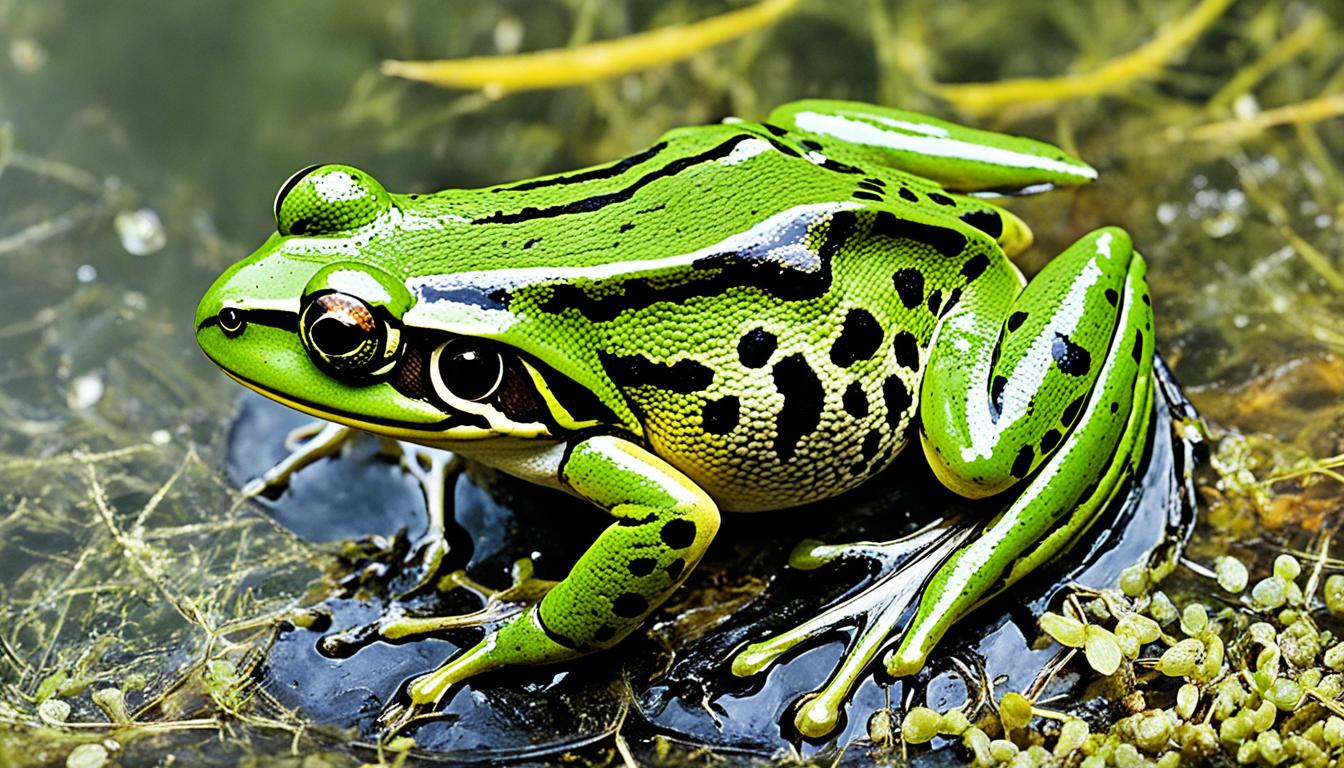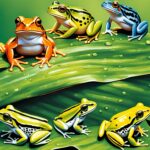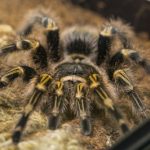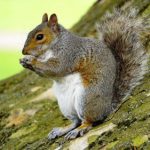Ever wondered how to tell the many frog species apart in your yard? Identifying them needs a close look at their size, color, and markings. These can look very different from one type of frog to another.
Where they live is also key. Different frogs prefer living in various places, like wetlands or forests. Plus, every frog species has a unique sound it makes. You can match these sounds to online recordings for help in identifying them.
For tougher cases, expert groups like SAVE THE FROGS! offer advice. But, can these steps work even when frogs look very nearly the same? Let’s find out.
Introduction to Frog Identification
Frog identification is both captivating and crucial for many reasons. It aids in biodiversity conservation and ecological studies. This helps protect and preserve frog species. By learning to identify various frogs, anyone can help in conservation.
Importance of Identifying Frog Species
It is important to know how to identify frogs for several key reasons. Recognizing species is vital for keeping the environment in balance. It prevents the loss of different life forms. Understanding frog types helps scientists monitor their well-being and the health of their homes. It also makes it easier to spot newcomers that might harm local ecosystems.
Overview of Frog Identification Techniques
Different frog identification techniques help tell species apart. Methods include:
- Visual Assessment: Looking at size, color, and markings to identify them.
- Habitat Observation: Knowing where different frog species live.
- Bioacoustics Analysis: Listening to their calls, especially during mating seasons, to recognize them.
- Digital and Printed Resources: Using guides, databases, and apps specifically for frog identification.
- Expert Networks: Getting help from people who study frogs, like herpetologists, and other frog enthusiasts for accurate ID.
It’s also smart to take detailed photos of frogs. Good images allow for comparison with guides and online resources. This is crucial for getting the identification right.
Physical Characteristics of Frogs
It’s important to know a frog’s unique traits to tell them apart. This includes details like their size, shape, and colors. Each frog’s unique look is part of what makes it special.
Size and Shape
In the USA, frogs come in all sizes and shapes. Some are tiny and slender, while others are big and solid. To identify them, we measure their length from nose to tail.
Color and Patterns
Looking at a frog’s colors and patterns is crucial for identifying them. They can be bright green, yellow, or even dull brown. The patterns, like spots or stripes, help us distinguish one from another.
Unique Physical Features
Different frogs have unique features that help us spot them. This includes webbed feet, bumpy skin, and distinct skin colors. By looking at these special traits, we can figure out which kind of frog we’re seeing.
How Habitat Influences Frog Species
Understanding how habitats impact frogs is key to identifying them. When you study American frogs, think about where they live. This is vital because these amphibians live in varied places.
Wetland Habitats
Wetlands abound with many frog types due to their watery homes. These places help frogs grow from tadpoles to adults. Places like ponds, lakes, and marshes are perfect for lots of American frogs.
Forest Habitats
Frogs in forests find lots of places to hide and food to eat. They often have looks that help them disappear in the woods. Spotting frogs means looking at how they look and where they live.
Urban Habitats
Even in cities, you can find frogs. Some have adapted to living near people, in places like gardens and ponds. To find and name frogs in these new homes, we must see how they use city spots to survive.
Geographical Distribution of Frogs in the USA
Frogs spread all across the United States, and this has a big effect on knowing what species they are. To make a frog species identification guide work well, we must understand these patterns.
Frogs of the Eastern USA
In the east, you’ll find frogs like the American Bullfrog and the Spring Peeper. They love the wet, humid weather and can be seen in a range of places like wetlands to forests. Figuring out where these frogs like to live is key to spotting them.
Frogs of the Western USA
Over in the west, different frogs make their homes, such as the Pacific Treefrog and California Red-legged Frog. These frogs are used to different weather, from the coast to the mountains. It’s important to know their special habitats when using a frog species identification guide.
Endemic and Introduced Species
There are frogs in the USA that belong and some that came from elsewhere. Frogs like the Wood Frog live in just a few places, but others, like the Cuban Treefrog, have spread too far. Knowing about all these frogs and where they live helps in recognizing them and looking after their homes.
Frog Calls as an Identification Tool
Frog calls are very unique and help in identifying American frogs. Each frog species has its own special sound which is most heard during their mating season. To properly use these calls for identification, you need to know how to listen and have the right tools.
Recording and Analyzing Frog Calls
To ID a frog by its call, you first need to record the sound. You can do this with a smartphone or any recording device. Try to get the clearest sound by keeping background noise to a minimum. After you’ve recorded frog sounds, you analyze them by comparing to what experts already know.
Resources for Frog Call Identification
For identifying American frogs by their calls, there’s an array of tools to assist you. Websites, apps, and online databases have lots of recorded frog sounds. The North American Amphibian Monitoring Program (NAAMP) and the “FrogID” app are just two examples with a huge collection of frog calls. These are great places to start your search.
The Role of Field Guides and Online Resources
Using field guides and online resources helps a lot in identifying frog species. These tools give detailed information. They also explain methods to spot the important features of different frogs.
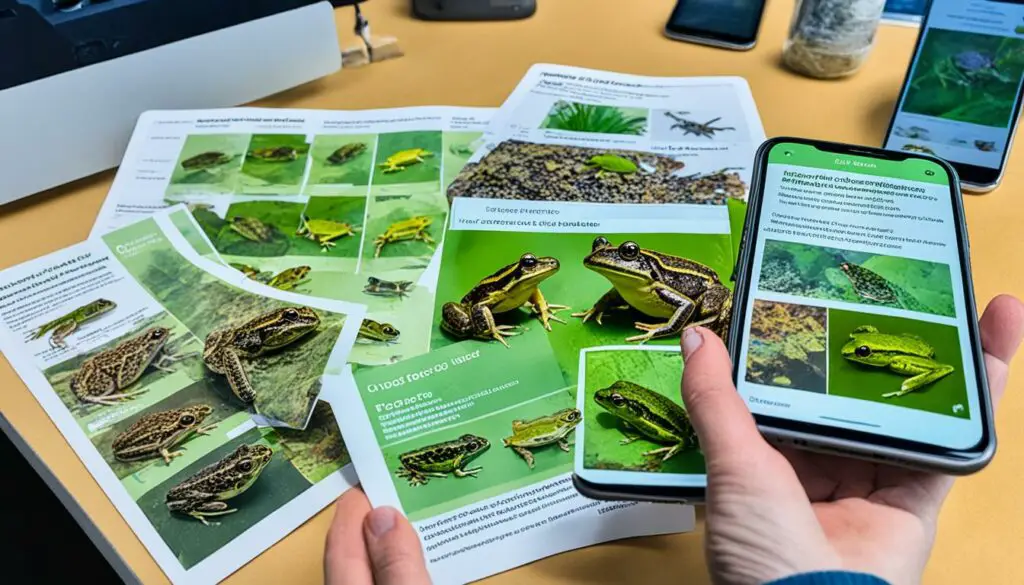
How to Use a Dichotomous Key
A dichotomous key is a great tool for identifying frogs. It works by asking you to pick between two traits. Each choice helps you get closer to the right frog species. This way, you can identify frogs accurately. It’s a trusted frog identification techniques.
Recommended Field Guides for American Frogs
For those who love studying frogs, field guides are a must. Here are some great ones:
- Petersen Field Guide to Reptiles and Amphibians of Eastern and Central North America by Robert Powell, Roger Conant, and Joseph T. Collins.
- Amphibians and Reptiles of the Carolinas and Virginia by Jeffrey C. Beane, Alvin L. Braswell, Joseph C. Mitchell, and William M. Palmer.
- Western Reptiles and Amphibians by Robert C. Stebbins.
These guides are packed with detailed descriptions and pictures. They also have info specific to certain areas. This makes them very useful for recognizing frog species.
Useful Online Resources
Online, you’ll find great resources for identifying frogs too. Websites like AmphibiaWeb and HerpMapper have large directories and photos helpful for your fieldwork and studies. FrogWatch USA‘s database is great for comparing frog sounds while identifying them.
Using both field guides and online resources is a powerful way to get better at recognizing frog species. It makes the identification process more manageable. This way, you can more easily identify and track various frogs.
Common Frog Species in the USA
When you look at the frog types in the United States, you see many interesting species. Each one has its own special traits. We’re going to talk about some frogs you see often: the Eastern Cricket Frog, Eastern American Toad, and Gray Treefrog.
Eastern Cricket Frog (Acris crepitans)
The Eastern Cricket Frog is quite small but stands out with its unique call. It sounds like pebbles being gently rubbed. You can usually find them close to water, which makes them easy to find when exploring nature.
Eastern American Toad (Anaxyrus americanus)
catches your eye with its strong build and changing colors. They can be different shades of brown, beige, or even green. Everywhere from the woods to your backyard, you might spot this toad, showing how tough and adaptable it is.
Gray Treefrog (Hyla versicolor)
When you think of common frogs in the USA, the Gray Treefrog is one you remember. Its gray colors help it blend almost perfectly with tree bark and other spots. You can find these frogs both in the wild forests and even behind houses in the city.
| Species | Distinguishing Features |
|---|---|
| Eastern Cricket Frog | Resonant call, small size |
| Eastern American Toad | Varied coloration, warty skin, robust form |
| Gray Treefrog | Mottled gray coloring, excellent camouflage |
Challenges in Frog Identification
Identifying frogs is tough because many look alike. They can vary in color and change with the seasons. This makes detailed understanding key to getting it right.
Similar-Looking Species
Some frogs look very similar, like the Cope’s Gray Treefrog and the Gray Treefrog. They are hard to tell apart without a close look or hearing their unique calls.
Variability in Coloration
Even frogs of the same type can look quite different, especially the American Green Treefrog. They might be bright green or dull brown, depending on their location and genetics. So, color isn’t always a reliable identification method.
Seasonal Changes and Their Effects
In various seasons, frogs change physically. They might change skin color or texture. This is their way of adapting to the environment. Remembering these changes is crucial when trying to identify them.
| Challenge | Description | Example Species |
|---|---|---|
| Similar-Looking Species | Frogs that visually resemble each other closely | Cope’s Gray Treefrog and Gray Treefrog |
| Variability in Coloration | Color differences within the same species | American Green Treefrog |
| Seasonal Changes | Physical alterations in response to seasons | Multiple species |
Consulting Experts and Citizen Science Platforms
Learning to identify different species of frogs in the USA needs expert advice and help from citizen science. Experts and citizen science groups put you in touch with lots of people who know a lot about frogs. They are helpful in finding detailed information, especially on frogs with tricky differences.
Citizen science is key in frog identification. Joining these projects means you’re part of a team that checks and confirms what frog species are found where. SAVE THE FROGS! is one place full of chances to learn from others who love frogs. This work helps in keeping records and protecting frogs nationwide, making spotting and naming frogs more accurate.
Being part of these groups not only sharpens your skills in spotting frog species. It also helps take care of the environment and the frogs living there. They combine everyone’s knowledge to make figuring out which frog is which more precise and enjoyable. So, teaming up with experts and citizen scientists is a big plus for those interested in all the different frog types the US has.

